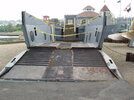Jakko, I'd interpret "double skin mahogany” as meaning, not plywood, but two layers of planking, which would logically be diagonal, probably at 90 degrees between the layers. There might well have been a steel plate fitted over that, to protect the wood. Looking at the door and bulkhead in your earlier post, they certainly look to me like steel panels bolted or riveted onto a wooden structure.
Pete
Pete




 . I'll join the audience being sure I'll learn something new.
. I'll join the audience being sure I'll learn something new.
